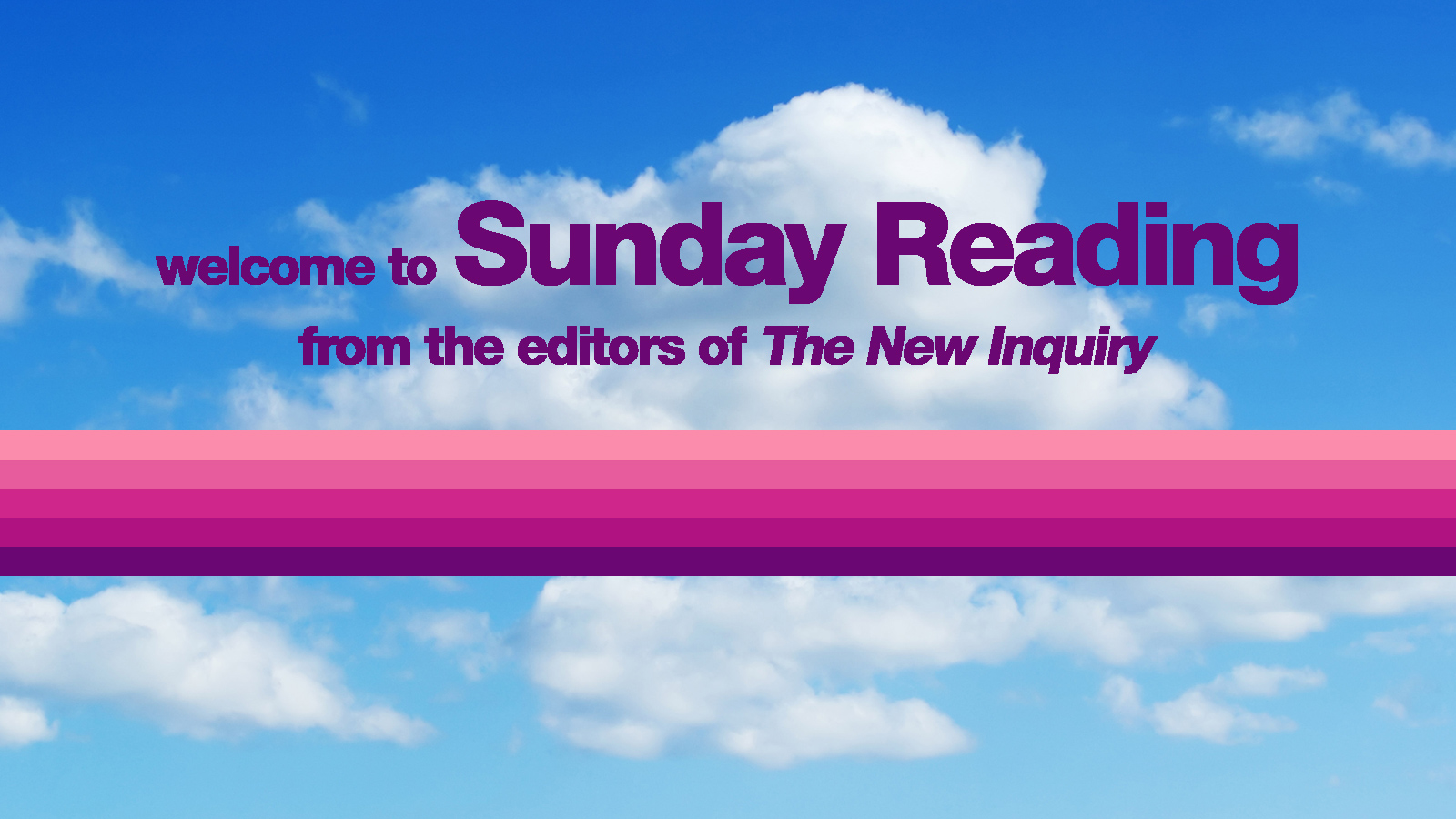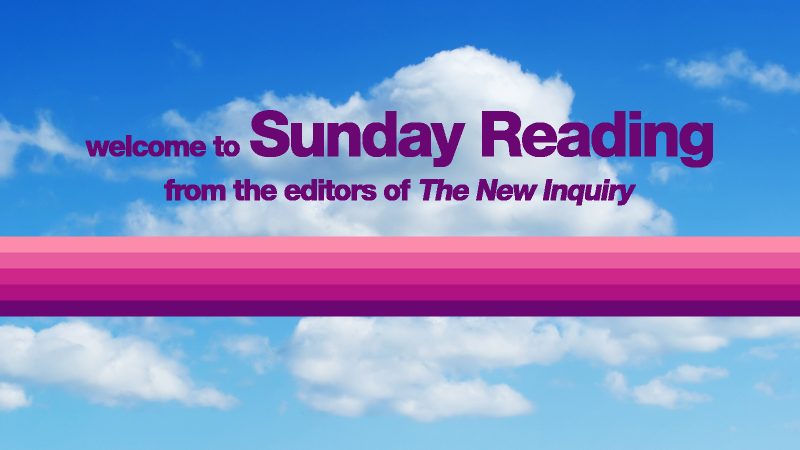

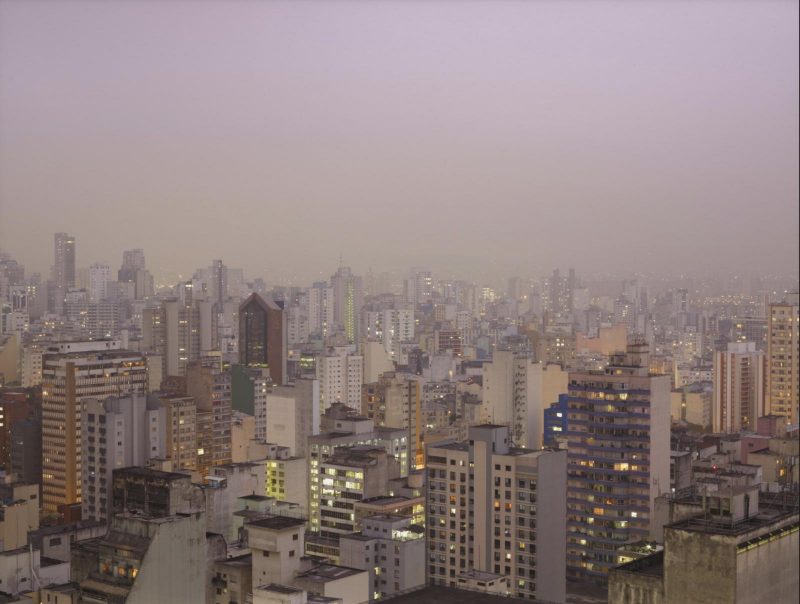
"Purple Haze" (2011) by Suwon Lee
Suwon Lee is a Korean-Venezuelan artist with several photographs currently on view at MoMa. This photo, “Purple Haze,” is part of a tetraptych featuring some of the most photographed and artistically rendered sites in Latin America. “Purple Haze” was taken at the Edificio Copan in São Paolo; here, the artist turns outward to the city that surrounds the storied building. Constructed as Brazil’s answer to the Rockefeller Center, Edificio Copan is one of the largest residential buildings in the world. Contemporary coverage of the structure focuses on the diverse population that lives among the 1,160 units. These accounts often push a narrative of peaceful democratic co-existence and group problem-solving, always juxtaposed to a previous era dominated by suburban flight and de-gentrification. This coverage usually features a law-and-order fairy tale by which the building’s eighty-year-old manager “cleaned up” the Edificio Copan through eviction of sex workers and drug dealers. Rarely mentioned in this gentrification story are the 36.6% (and growing) of Brazil’s urban population that lives in slums. The purple haze Lee features––recently exacerbated by a rise in forest fires––blankets all Brazilians, but some have no escape. The photo, along with a number of other works gifted by Patricia Phelps de Cisneros, is on view until September 9.
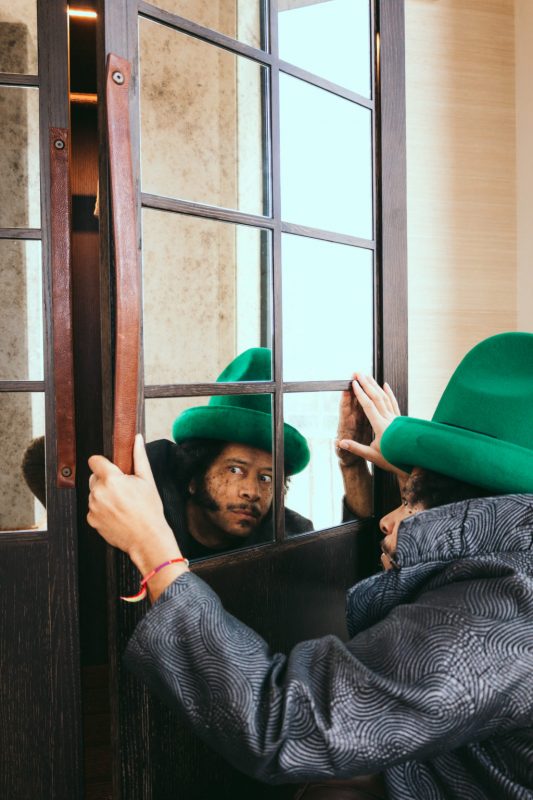
Edward Ongweso Jr. Profiles Boots Riley in Broken Pencil
If you haven’t learned how to torrent yet, Boots Riley’s new show I’m A Virgo is a great excuse. Don’t watch it on Amazon Prime, but find a way. The show, which chronicles nineteen-year-old Cootie’s experiences as a thirteen-foot-tall Black man in Oakland, builds on the same absurdist aesthetics Riley used in Sorry to Bother You (2018). And while you’re waiting for it to download, check out Edward Ongweso’s delightful Broken Pencil profile of the filmmaker. In this piece, the duo drills down the relationship to Riley’s sonic projects and filmography––including the music-forward way he is conceptualizing his work. If Sorry to Bother You is the lead single, I’m A Virgo is still hitting radio air waves, and the work so far leaves me ready for the deep cuts.
“NOTHING MAKES SENSE LOLOLOLOLOL!” by River L. Ramirez
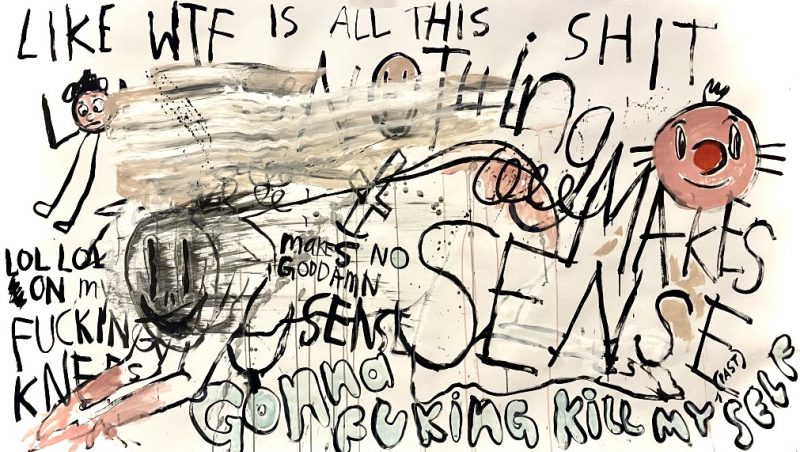
Since the pandemic began, the average NYC rent has gone up 15%. Meanwhile, current inflation levels have increased 6% from 2022-2023. If New Yorkers want to spend the recommended 30% of their overall income on rent, they would have to make $134,000 a year. But, as of this August, the average annual income in NYC is just $50,761.
How is anyone making it work? And how are rising costs impacting not just the rental market, but cultural production, as a city that was once an artist haven becomes unaffordable for most artists?
There are two answers to this question: artists are either supplementing their income with inherited wealth, or they’re getting crushed, a contradiction that artist River L. Ramirez analyzes in “Nothing Makes Sense LOLOLOLOLOL!” Ramirez is perhaps best known for their comedy, with roles in Los Espookys and Julio Torres’ Problemista, and this background shines through their visual art. Ramirez’s large-scale works are like reading a comic where all the panels have disintegrated and the characters have been jostled into a single frame, expressing a breakdown in social reproduction, and the cascade of intrusive thoughts that come with trying to survive the collapse.
“Order falls out the window when you’re the percentage that should not exist here,” Ramirez told me. “So nothing makes sense. Including yourself.” Humor and horror knock against each other like a smiling cartoon with a knife in its back.
“NOTHING MAKES SENSE LOLOLOLOLOL!” is on view at Brick Aux in New York City through September 17.
Socialism Conference 2023
The blessing and curse of the socialism conference is that so much cool stuff is happening at the same time. It’s like going to Coachella and wanting to see all the headliners, except it’s socialist coachella, and instead of Black Pink, Bad Bunny, and Blink-182, the heavy-hitters are Angela Davis, Harsha Walia, and Ruth Wilson Gilmore. In the real socialist utopia, these pop stars and public intellectuals will finally collab.
No matter where you end up, it’ll be hard to go wrong. But in case you’re having trouble choosing, here are some of the panels that we’re most excited about:
“Decolonial Disability Politics and the Left” with Shira Hassan, Jules Gill-Peterson, Jasbir Puar and Beatrice Adler-Bolton
In The Right to Maim (2017), Puar analyzed the up until then extremely white field of disability studies through the lenses of empire and race. Since the nineties, the proponents of the western liberal disability framework––much like western homonationalists, a term Puar also invented––has relied on “pride.” Instead of being ashamed of their disability, the disabled and chronically ill are encouraged to be “proud” of their capacity to participate in capitalist individualism, and to only seek structural change by getting a seat at the proverbial table. But, as Puar points out, “pride” is an off-putting format for Palestinians intentionally disabled by Israeli sniper fire, or Latinex migrants who develop chronic health issues as a result of long-term holds at carceral detention centers. Puar thus amends Foucault’s claim that the sovereign enjoys the right to kill by arguing that the sovereign also enjoys the “right to maim,” or to maintain in a state of permanent injury as a means of biopolitical extraction and control.
It will thus be thrilling to hear Puar in conversation with Shira Hassan, author of Saving Our Own Lives; Jules Gill-Peterson, author of Histories of the Transgender Child; and TNI columnist Beatrice Adler-Bolton, co-author of Health Communism. The panel will focus on peer-led work, links between the trans and disability justice movements, feedback loops between empire and debility, and liberatory harm reduction.
“The Palo Alto System” with Malcom Harris:
In an interview with the Guardian, Harris is asked how he came to understand the historical circumstances which created Silicon Valley. He responds with the following: “I read Charles Marvin’s description of the ‘Palo Alto System,’ a new scientific method of breeding and training horses developed by Leland Stanford in the 1880s, and how they were running through these young horses at a higher rate, and busting their limbs.” He compares this to the way Silicon Valley breaks young people in both the periphery and the imperial core. Throughout the 2010s, suicides were endemic at Foxconn, the Chinese factory which produced iPhones, and at Palo Alto High, largely attended by the children of Silicon Valley’s PMC. Harris links this extraction and disposal of youth to Silicon’ Valley’s settler colonial history of moving fast and breaking things: when you remember that California was built on indigenous genocide, the “huge swing back towards eugenic philosophy in Palo Alto” comes as less of a surprise. Harris is a former TNI editor; his archive of TNI essays is available here, and TNI is proud to be sponsoring his event.
 Lee Cataluna and Naomi Klein on Loss in Lahaina
Lee Cataluna and Naomi Klein on Loss in Lahaina
“It’s surreal to sit in the dark, listening to a battery-powered radio, hearing people from around the country talk about sending you stuff like blankets and socks … you’re thinking, ‘Thanks, but Hawaii is too hot for blankets right now, and I don’t even have shoes,’” writes Lee Cataluna in Honolulu Civil Beat. Her insider’s perspective is invaluable. As the news of the fires in Lahaina broke, the story metastasized into a discursive weapon on all sides. To liberals, it was a chance to support the American Red Cross’ valiant fund mismanagement efforts. To right-wing conspiracy theorists, it was an opportunity to push the narrative that there was a UN-backed land grab in service of “smart cities” and 5G expansion. And to those across the political spectrum, it was simply a chance to send socks and blankets to a tropical island in service of their own feelings. Cataluna’s evocative piece re-centers the actual people of the island and the devastation they have experienced.
Outside observers are not the only ones contorting the motivations and needs of Maui’s people: as Naomi Klein notes in The Guardian, the developer class has used this emergency to suspend a hard-won water permit structure that “the community hoped would restore public control over water that had been stolen for over a century.” Disaster plantation capitalism, a term that nods to the legacy of colonialism and labor exploitation on the islands, succeeds when this class can argue that the community has no right to its own water management, and that the island’s water should be directed to luxury resorts and not to Maui’s citizens. This paternalist dynamic, in which "capitalists know best," is a forerunner to the water rights cases that will continue to pop up as ecological disaster becomes more commonplace. It is in all of our interest to keep eyes on Lahaina, and continue to listen to its citizens about what they truly need.
